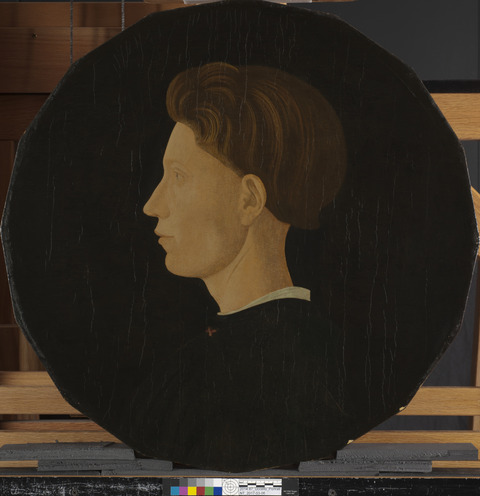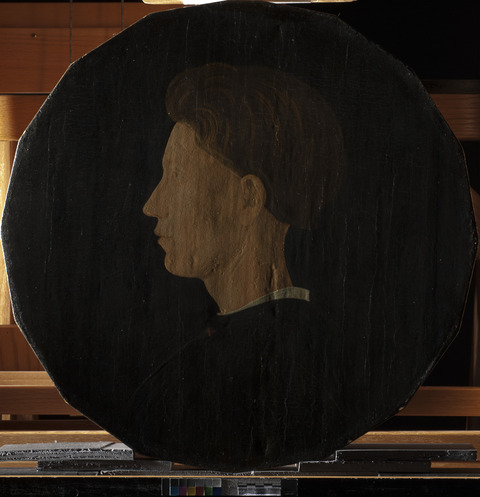Overview
Identification number: 2014.87
Artist: Attributed to Paolo Uccello
Title: Portrait of a Young Man
Materials: Tempera and/or oil (untested) on wood panel
Date of creation: 1430s–1450s
Previous number/accession number: C10077
Dimensions: 57 × 56.6 cm
Conservator/examiner: Roxane Sperber with contributions from Gregory D. Smith
Examination completed: 2021
Distinguishing marks:
Front:
None
Back:
Item 1. Stamp with red ink, original panel between cradle members: “…./PARIS/ EXPOSITION” (tech. fig. 1).
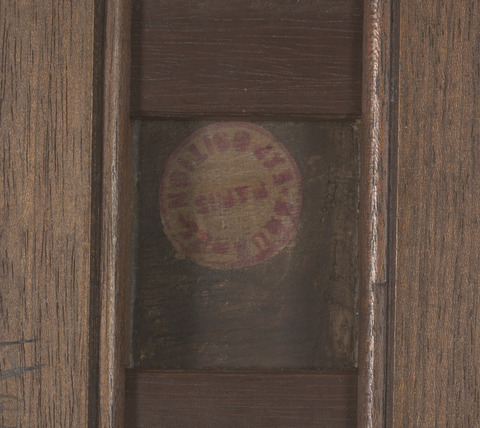
Item 2. Red pencil inscription on horizontal cradle member: “9981F” (tech. fig. 2).
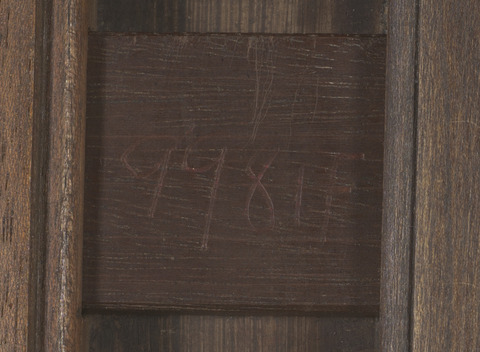
Item 3. Painted inscription in white on horizontal cradle member: “2014.87” (tech. fig. 3).
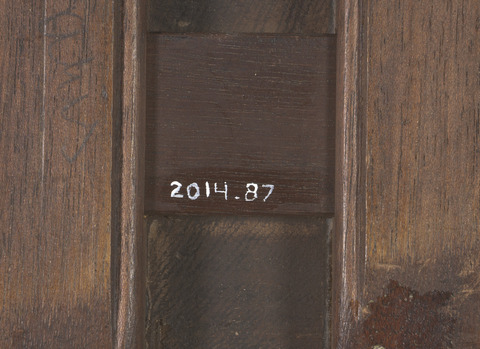
Item 4. Stamp with black ink, original panel between cradle members: “DOUANE/…/PARIS/CENTRALE” (tech. fig. 4).
Item 5. Stamp with black ink on horizontal cradle member, illegible (tech. fig. 4).
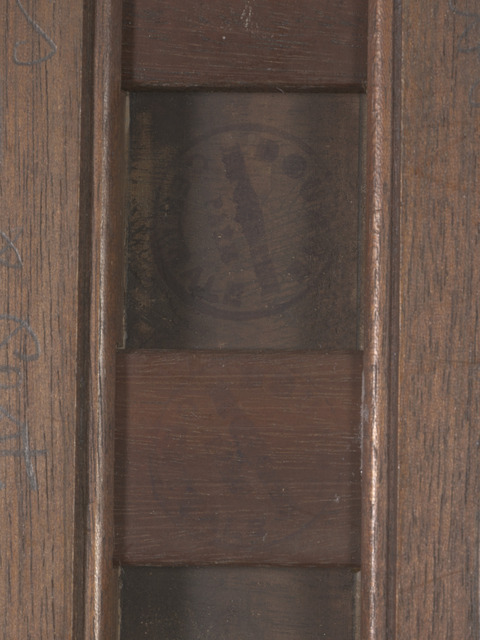
Item 6. Pencil inscription on vertical cradle member: “Calve Collection Paris” (tech. fig. 5).
Item 7. Pencil inscription on vertical cradle member, illegible (tech. fig. 5).
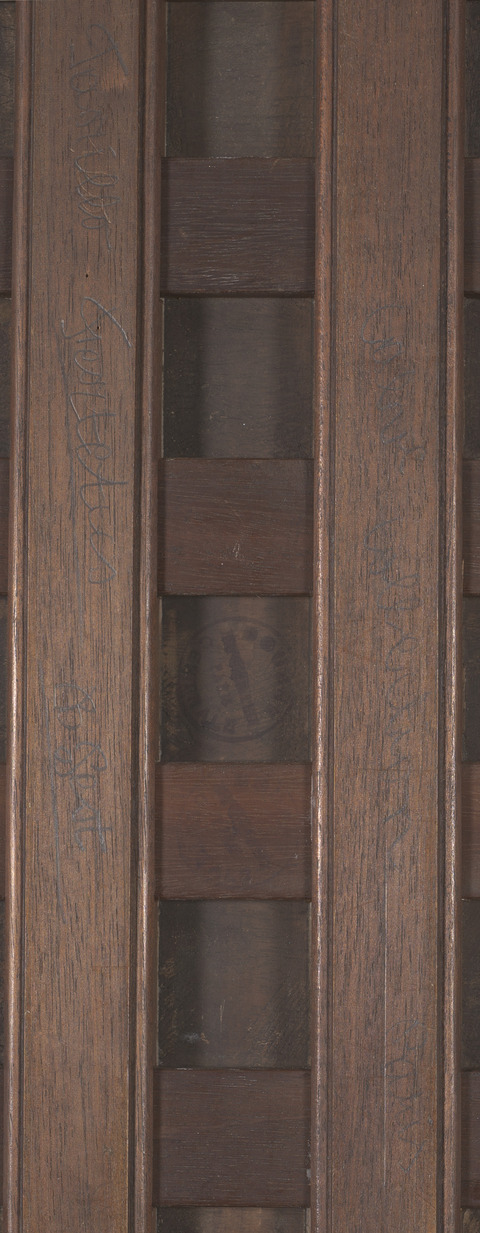
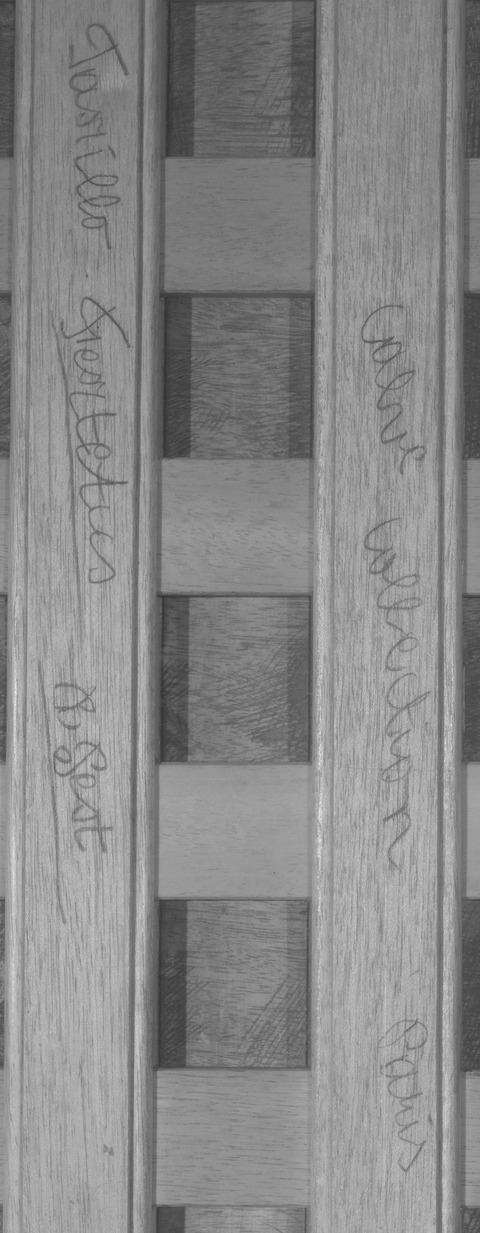
Item 8. Pencil inscription on vertical cradle member, illegible (tech. fig. 6).
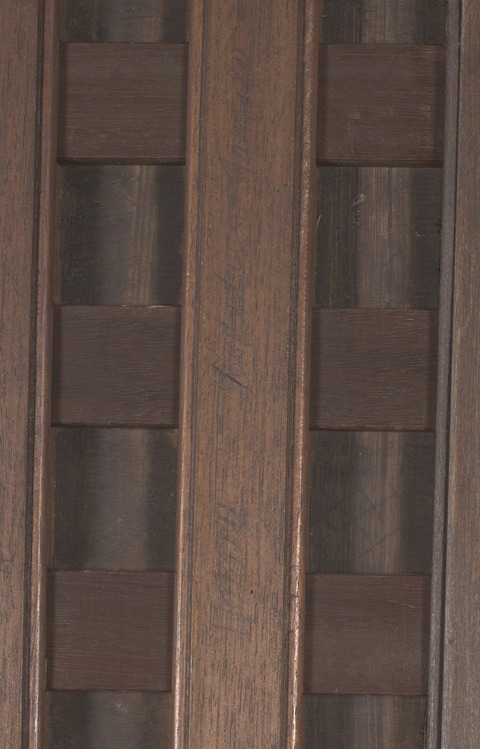
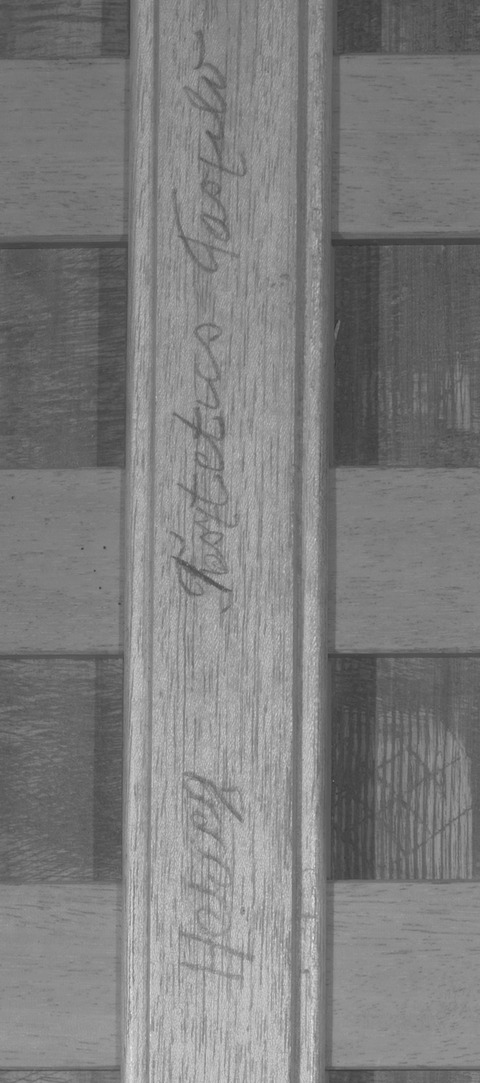
Item 9. Stamp with black ink, original panel between cradle members, very faded, illegible (tech. fig. 7).
Item 10. Scratched-out stamp on cream-colored paint, original panel between cradle members (tech. fig. 7).
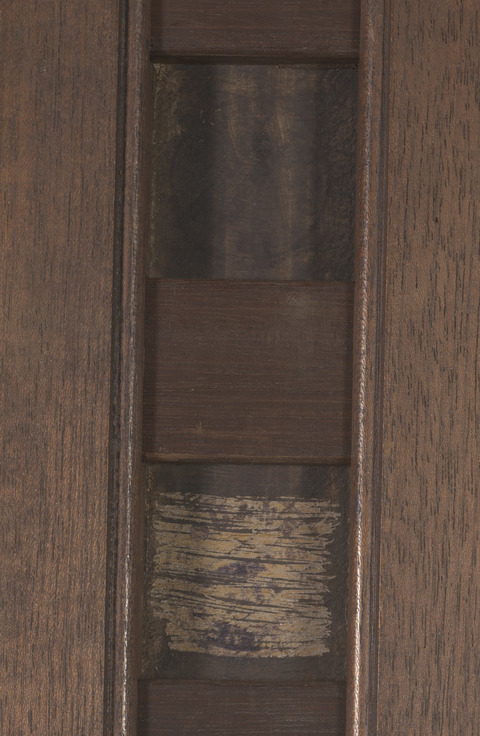
Summary of Treatment History
Physical alterations to the original painting suggest a long history of interventions. The physical support has been cut down, thinned, and marouflaged to a secondary support to which a cradle has been applied. Additions have been added around the edges of the once-rounded panel to create the hexadecagon support. The background has been entirely overpainted to mask the border between the edge additions and the original panel. There is a thick, discolored varnish on the painting’s surface as well as at least one campaign of discolored retouching. It appears that some effort was made to mask these interventions, perhaps to pass the work off as completely original.
A condition assessment was carried out at the Fogg Museum in September 1966. In this report the examiner noted that the craquelure on the painting is unusual and that the edges of the painting were completely soluble in acetone. The examiner determined the painting to have been created during the twentieth century, likely in about 1920, based on this solubility test along the edge. This area has since been shown to be a later addition, accounting for its increased solubility.1
Documentation suggests a series of condition assessments and treatments were carried out on the collection about the time the works were moved from the Clowes residence to the IMA in 1971. A condition report by Paul Spheeris in October of that year, likely carried out before the paintings were relocated, described the painting as having a scratch on the top left. He did not recommend the painting receive treatment.2 A second condition assessment was carried out upon arrival of the paintings at the IMA. This assessment described the work as in “stable condition” and no treatment was deemed necessary. An X-radiograph of the painting was made at this time.3
In 1996, a memorandum summarizing treatment and examination of the Clowes Collection from the time it entered the museum suggests that the painting had a surface cleaning in 1990 and was the subject of ongoing technical study.4 XRF analysis was carried out in March 2018.
The painting was previously examined and documented in the annual Clowes Reports from 2012 to 2020.
Current Condition Summary
The poor condition of the object compromises aesthetic appreciation of the painting and study of its original function. The work is structurally stable although the original support shows evidence of extensive woodworm damage that may have prompted structural interventions. The paint layer is severely abraded, likely from previous cleaning interventions. The varnish has yellowed, and the retouching and overpaint have discolored over time.
Methods of Examination, Imaging and Analysis
| Examination/Imaging | Analysis (no sample required) | Analysis (sample required) |
|---|---|---|
| Unaided eye | Dendrochronology | Microchemical analysis |
| Optical microscopy | Wood identification | Fiber ID |
| Incident light | Microchemical analysis | Cross-section sampling |
| Raking light | Thread count analysis | Dispersed pigment sample |
| Reflected/specular light | X-ray fluorescence spectroscopy (XRF) | Fourier-transform infrared spectroscopy (FTIR) |
| Transmitted light | Macro X-ray fluorescence scanning (MA-XRF) | Raman microspectroscopy |
| Ultraviolet-induced visible fluorescence (UV) | ||
| Infrared reflectography (IRR) | Gas chromatography–mass spectrometry (GC-MS) | |
| Infrared transmittography (IRT) | Scanning electron microscope -energy dispersive X-ray spectroscopy (SEM-EDS) | |
| Infrared luminescence | Other: | |
| X-radiography |
Technical Examination
Description of Support
Analyzed Observed
Material Type (fabric, wood, metal, dendrochronology results, fiber ID information, etc.):
The painting was executed on wood panel. It was not possible to identify the wood type due to the marouflage added to the back of the original panel as well as edge additions (see tech. fig. 8).
Characteristics of Construction/Fabrication (cusping, beveled edges of panels, seams or joins, battens):
The support has been significantly altered from its original construction. The original portion of the panel has vertically oriented wood grain. No obvious joints are visible in the X-radiograph suggesting what remains of the original panel was composed of a single plank (approximately 45 cm wide) (tech. fig. 8, magenta area). The X-radiograph reveals that the top and bottom of the original panel are curved, suggesting the original construction of the panel may have been circular and was later trimmed on the right and left sides, which are now straight. It is also possible that the original panel was originally rectangular and was later cut to have an arched top and bottom edge.
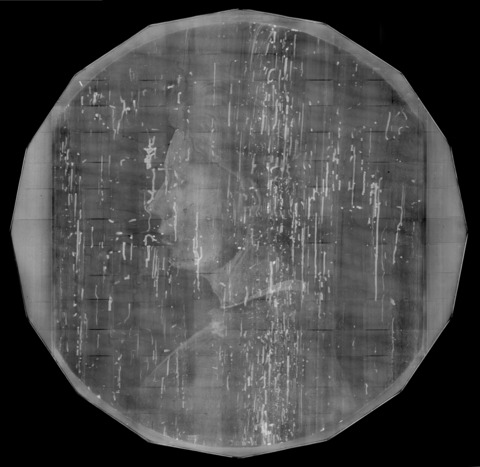
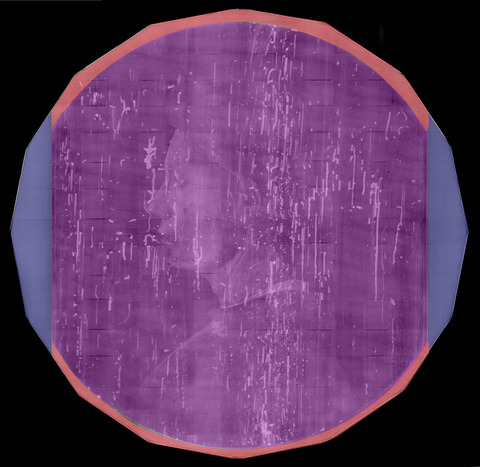
Edge pieces have been added to all sides of the original panel to transform it into a hexadecagon (a 16-sided polygon). On the top and bottom, pieces are fitted around the curved edges of the original panel (tech. fig. 8, red area). On the right and left sides, edge pieces in the form or irregular pentagons have been added (tech. fig. 8, blue area).
The entire construction is marouflaged to a backing panel that is also a hexadecagon. A cradle is attached to the backing panel (see Auxiliary Support). The edges of this construction are covered by a ground layer to obscure visual clues to the structure. It is clear that significant effort was made to make it look like the backing panel was original and not a later addition.
Thickness (for panels or boards):
The panel in its current construction is approximately 1 cm thick. The cradle is 1.7 cm thick, making the full support 2.7 cm thick. The original panel and the edge pieces are approximately 0.5 cm thick. The backing panel is 0.5 cm thick.
Production/Dealer’s marks:
None
Auxiliary Support:
Original Not original Not able to discern None
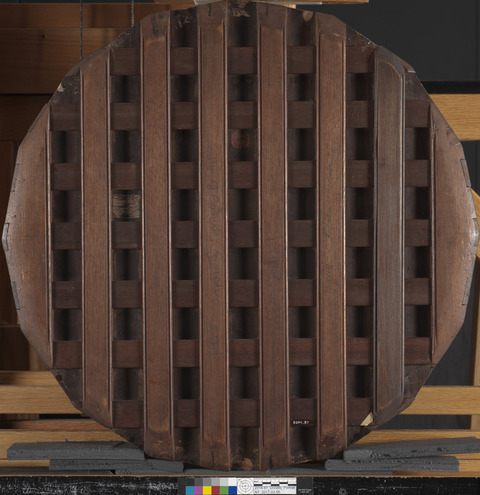
A cradle has been fixed to the backing panel (tech. fig. 9). The cradle is composed of eight vertical members that are fixed in place. The central six members are 3.5 cm wide, while the right and left members are slightly wider and have been cut to mirror the edges of the hexadecagon. The cradle has seven horizontal movable members that are 3 cm wide. Many of these horizonal members have seized.
Weave (structure, weight, thread thickness, etc.):
N/A
Condition of Support
The original support has been severely altered from its original state. The X-radiograph reveals extensive woodworm damage to the original support that may have prompted such interventions. The current construction of the support is in stable condition. The panel is in plane, and the edge strips are well joined and strongly adhered.
Description of Ground
Analyzed Observed
Materials/Binding Medium:
The original ground (tech. fig. 10) is visible in gaps between areas of paint. The presence of calcium in all of the XRF spectra on the original panel suggest the original ground is calcium-containing. An unoriginal ground layer applied to the edge additions is a brighter white and more opaque (tech. fig. 11). The craquelure on the original panel is an age crack pattern following the vertical orientation of the grain. This crack pattern does not extend onto the panel’s edge additions
Color:
The original ground is beige (tech. fig. 10) while the ground on the additions is a bright white (tech. fig. 11).
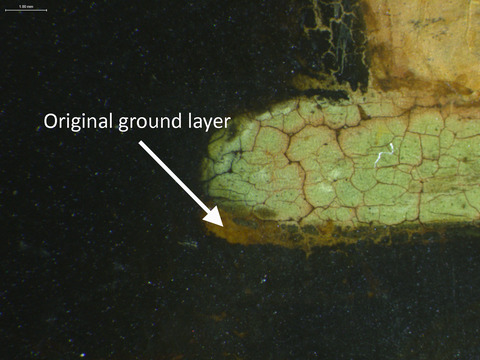
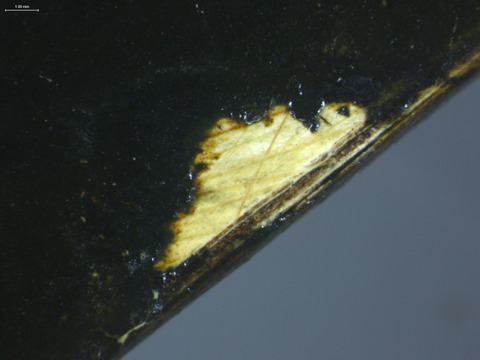
Application:
The original ground was likely applied over a size layer with a brush and smoothed flat. Losses revealing the ground on the additions have a scratched surface suggesting they were scaped flat to create an imperceptible transition from the original panel to the additions (tech. fig. 11).
Thickness:
The ground layer is quite thin.
Sizing:
None visible
Character and Appearance (Does texture of support remain detectable/prominent?):
The panel is extremely smooth. Seamless transitions between the edge additions and the original panel make the joins difficult to detect in visible light. It is possible that the ground layer on the additions was extended onto the original panel and smoothed flat to mask the edge. Some minimal age cracking is visible on the original panel but does not extend onto the additions.
Condition of Ground
The grounds on the original panel and the edge additions are in stable condition.
Description of Composition Planning
Methods of Analysis:
Surface observation (unaided or with magnification)
Infrared reflectography (IRR)
X-radiography5
Analysis Parameters:
| X-Ray equipment | GE Inspection Technologies Type: ERESCO 200MFR 3.1, Tube S/N: MIR 201E 58-2812, EN 12543: 1.0mm, Filter: 0.8mm Be + 2mm Al |
|---|---|
| KV: | 26 |
| mA: | 3.0 |
| Exposure time (s) | 120 |
| Distance from X-ray tube: | 36″ |
| IRR equipment and wavelength | Opus Instruments Osiris A1 infrared camera with InGaAs array detector operating at a wavelength of 0.9–1.7µm. |
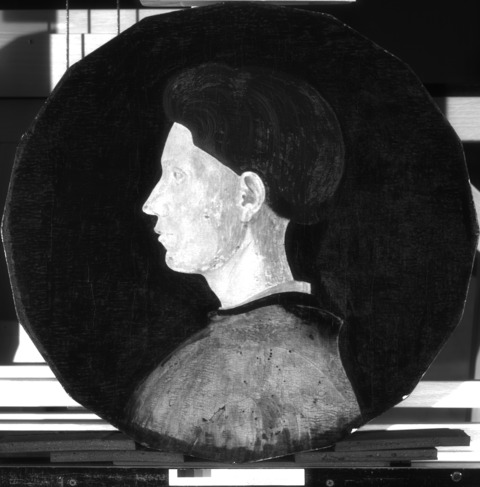
Medium/Technique:
No underdrawing is visible on the panel when imaged using infrared reflectography (tech. fig. 12).
Description of Paint
Analyzed Observed
Application and Technique:
The severely abraded quality and extensive overpaint on the painting makes it difficult to observe the original painting technique. The face appears to have been painted with small, controlled brushstrokes with the direct application of shadows, midtones, and highlights to create the illusion of form. Although difficult to appreciate in the current condition, evidence suggests the flesh was once carefully articulated to create the illusion of form. The hair has a flatter appearance with a brown layer applied first over which strands of yellow hair were painted.
The clothing was painted with a rather flat, dark green color and a few sweeping incised lines to define the man’s shoulder. Form does not appear to have been articulated in the drapery, although darkening of the paint layer may have obscured once-present, subtle nuances.
Painting Tools:
Small to medium brushes
Binding Media:
Tempera and/or oil (untested)
Color Palette:
The color palette is very muted, consisting mainly of browns, black, white, red, and green. The man’s eye is blue (tech. fig. 13), but the color has faded. The elements detected using XRF suggest the use of lead white, iron-oxide earth pigments, vermilion, red lead, copper-containing green and/or blue pigments, and possibly ultramarine. Elements suggesting the presence of cerulean blue, cobalt blue, zinc yellow, and zinc white were detected in retouching and overpaint.
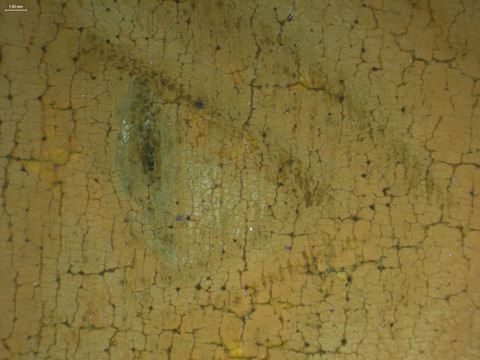
XRF Analysis
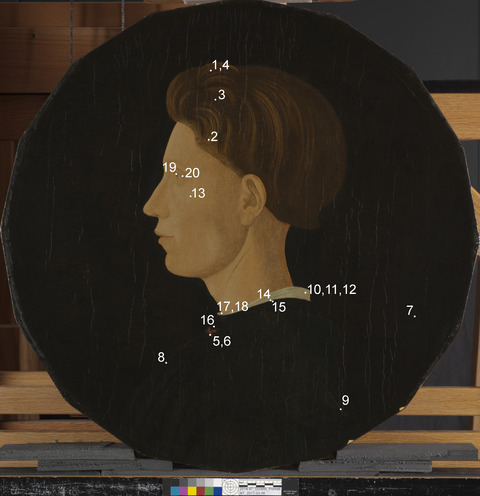
| Sample | Location | Elements* | Possible Pigments |
|---|---|---|---|
| 1 | Hair highlight | Major: Pb Minor: Fe, Hg Trace: Ca, Cu | Lead white, yellow earth, vermilion, calcium (from the ground layer), trace of copper-containing green and/or blue pigment. |
| 2 | Hair near temple | Major: Pb Minor: Fe, Hg Trace: Ca, Cu | Lead white, yellow earth, vermilion, calcium (from the ground layer), trace of copper-containing green and/or blue pigment. |
| 3 | Dark hair between samples 1 & 2 | Major: Fe, Hg Minor: Pb Trace: Ca | Yellow earth, vermilion, calcium (from the ground layer), trace of copper-containing green and/or blue pigment. |
| 4 | Same location as sample 1; 3 min. exposure | Major: Pb Minor: Fe, Hg Trace: Ca, Cu | Lead white, yellow earth, vermilion, calcium (from the ground layer), trace of copper-containing green and/or blue pigment. |
| 5 | Red cross tie of garment; on blue crack | Major: Cu, Pb Minor: Fe Trace: Cl, Ca, Mn, Hg, Sr | Azurite (exposed in crack), lead white or red lead, red earth, calcium (from the ground layer), trace of copper-containing green and/or blue pigment. |
| 6 | Red cross tie | Major: Pb Minor: Cu Trace: Cl, Ca, Mn, Fe, Hg, Sr | Red lead, underlying azurite, calcium (from the ground layer), trace of copper-containing green and/or blue pigment, trace of vermilion. |
| 7 | Background to the far, proper, right of the figure where there is a blue speck | Major: Co Minor: Ca, Sr, Sn Trace: Fe, Zn, Pb | Cerulean blue (cobalt stannate likely from retouching or overpaint), calcium (from the ground layer), trace of copper-containing green and/or blue pigment, trace of iron-oxide (earth pigments), trace of lead white. |
| 8 | Garment area below the red cross tie | Major: Ca, Fe, Sr Minor: Co, Zn, Pb Trace: Cl, Ti, Cr, Mn | Iron oxide (earth pigments), cobalt blue (likely from retouching or overpaint), zinc yellow, calcium (from the ground layer). |
| 9 | Garment along the figures back in an incised area | Major: Cu Minor: Ca, Fe, Sr Trace: Cl, Ba, Pb | Underlying copper-containing green and/or blue pigment, trace of iron oxide (earth pigments), calcium (from the ground layer), trace of copper-containing green and/or blue pigment. |
| 10 | White collar at nape of neck with craquelure | Major: Pb Minor: Ca, Fe, Zn, Sr Trace: Ti | Lead white, ocher, possibly zinc white, calcium (from the ground layer). |
| 11 | White collar from the area slightly above sample 10 | Major: Pb Minor: Fe Trace: Ca, Cu, Sr | Lead white, ocher, calcium (from the ground layer). |
| 12 | White collar from the incised area above sample 11 | Major: Pb, Ca Minor: Fe, Sr Trace: Ti, Cu, Zn | Lead white, ocher, calcium (from the ground layer). |
| 13 | Cheek area near eye | Major: Pb Minor: Sr, Hg, Fe Trace: Ca | Lead white or red lead, trace of vermilion, trace of red ocher, calcium (from the ground layer). |
| 14 | Red speck located between black collar and blue garment | Major: Cu, Pb Minor: Ca, Fe, Zn, Sr Trace: Hg, Cl, Mn | Red lead, iron oxide, copper oxide, calcium (from the ground layer). |
| 15 | Area adjacent to sample 14 toward garment | Major: Cu Minor: Ca, Fe, Pb, Sr Trace: (Cl, Ba, Mn, Hg | Azurite, iron-oxide (earth pigments), lead white, calcium (from the ground layer). |
| 16 | Area of the red cross tie that has been painted over. It is located slightly higher up the garment than the visible red cross tie. | Major: Cu, Ca Minor: Fe, Zn, Pb, Sr Trace: | Azurite from underlayers, trace of iron-oxide (earth pigments), trace of lead white, trace of calcium (from the ground layer) or gypsum for organic dye mordant. |
| 17 | White collar from the area to the front of the sitter | Major: Ca, Fe, Pb, Sr Minor: Zn Trace: Cl, Ba, Mn, Cu | Ocher, lead white, trace of calcium (from the ground layer), trace of zinc white (likely from extensive retouching). |
| 18 | Area slightly to the right of sample 17 | Major: Ca, Pb, Sr Minor: Fe, Cu, Zn Trace: Cl, Ba, Mn | Ocher, lead white, trace of calcium (from the ground layer), trace of zinc white (likely from extensive retouching). |
| 19 | Blue of the sitter’s iris— 600 uA | Major: Pb Minor: Fe, Hg Trace: K, Ca, Cu, Sr | Lead white, maybe ultramarine or lapis lazuli. |
| 20 | Area near the crease of the eye | Major: Pb Minor: Fe, Hg Trace: K, Ca, Cu, Sr | Lead white, maybe ultramarine or lapis lazuli. |
Table 1: Results of X-ray fluorescence analysis conducted with a Bruker Artax microfocus XRF with rhodium tube, silicon-drift detector, and polycapillary focusing lens (~100μm spot).
*Major, minor, trace quantities are based on XRF signal strength not quantitative analysis
Surface Appearance:
The texture of the surface is almost that of melted paint, raising the question of whether the painting underwent an intense heat treatment at some point in its history.
Condition of Paint
The paint layer is in severely damaged condition. Areas of the face and hair have been abraded leaving a ghost of an image (tech. fig 15). The background has been completely overpainted from the additions up to the edge of the figure (tech. fig. 16). A second campaign of retouching, which has now discolored, was subsequently applied over the overpaint (tech. fig. 17).

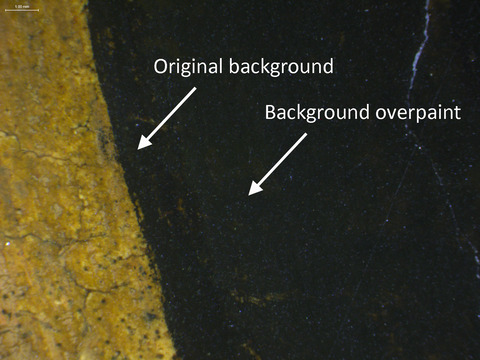
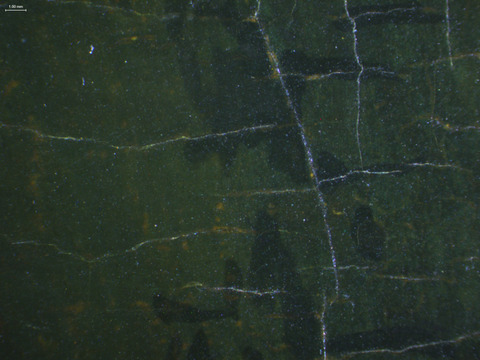
Description of Varnish/Surface Coating
Analyzed Observed Documented
| Type of Varnish | Application |
|---|---|
| Natural resin | Spray applied |
| Synthetic resin/other | Brush applied |
| Multiple Layers observed | Undetermined |
| No coating detected |
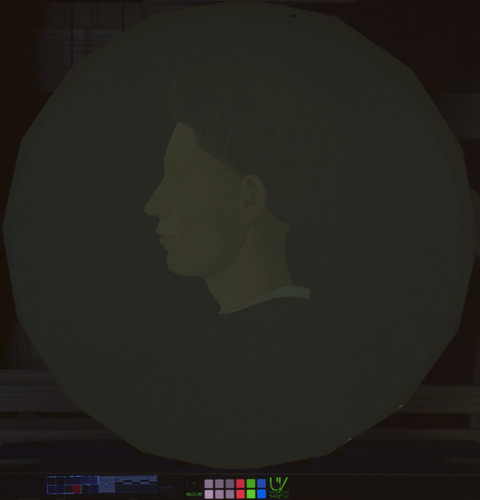
There is a thick, evenly applied surface coating that fluoresces strongly under ultraviolet-induced visible fluorescence (tech. fig. 18). Retouching or overpaint, which is visible under microscopy, is not visible in ultraviolet-induced visible fluorescence, suggesting these campaigns were applied under the top layer of varnish that fluorescence strongly.
Condition of Varnish/Surface Coating
The varnish is in acceptable condition. It has yellowed slightly but is well saturating and even. A large campaign of overpaint is present across the entire background as well as several campaigns of now mismatched retouching in the body, face, and background.
Description of Frame
Original/first frame
Period frame
Authenticity cannot be determined at this time/ further art historical research necessary
Reproduction frame (fabricated in the style of)
Replica frame (copy of an existing period frame)
Modern frame
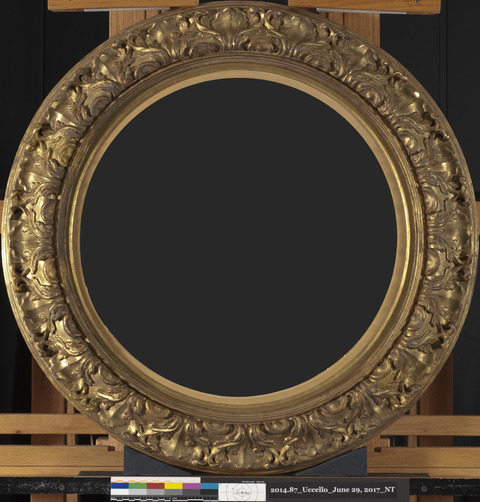
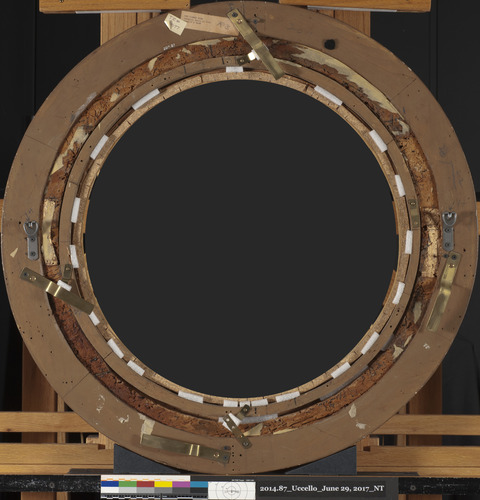
Frame Dimensions:
Outside frame dimensions: 81 cm diameter
Sight size: 54 cm diameter
Distinguishing Marks:
Front:
None
Back:
Item 11. Printed text on a paper label: “THE CLOWES FUND/UCCELLO, Paolo di Dono/ Head of a ManX,” and pencil inscription “R.3,” on the top of the frame (tech. fig. 21).
Item 12. Handwritten text with faded black marker on paper label on the top of the frame: “T.R. #/10077 (tech. fig. 21).
Item 13. White paint in handwriting on the top of the frame: “2014.87 (tech. fig. 21).
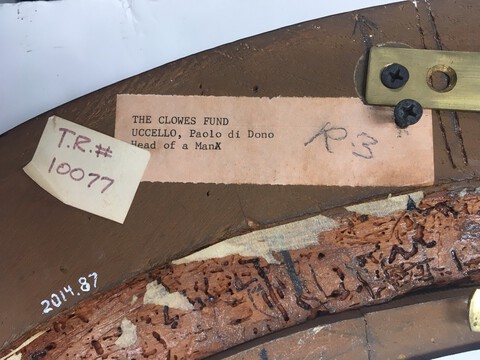
Description of Molding/Profile:
The frame was created in the style of 1680 and made in about 1850, likely in Rome (tech. fig. 20). The frame is carved wood with an acanthus leaf design covered in a layer of gesso and water gilding (tech. fig. 22). A thin oak strip has been added to the back to reinforce the structure (tech. fig. 21).6
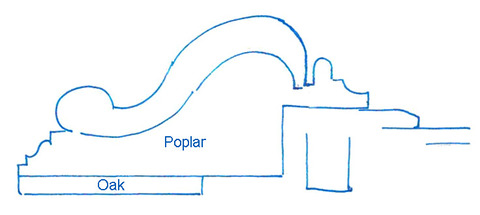
Condition of Frame
The frame is in good condition. Structurally the frame is stable and there are very few losses to the gilding.
Notes
-
“Paolo Uccello, Head of the Young Man,” condition Report from the Fogg Museum, September 1966. Conservation Department files, Indianapolis Museum of Art at Newfields. ↩︎
-
Paul A.J. Spheeris, “Conservation Report on the Condition of the Clowes Collection,” 25 October 1971, Conservation Department Files, Indianapolis Museum of Art at Newfields. ↩︎
-
Martin Radecki, Clowes Collection condition assessment, undated (after October 1971), Conservation Department Files, Indianapolis Museum of Art at Newfields. ↩︎
-
Memorandum from Martin Radecki to Bret Waller, “Conservation Work on Clowes Fund Collection,” 16 February 1996, Conservation Department Files, Indianapolis Museum of Art at Newfields. ↩︎
-
Elvacite 2040 (synthetic resin) was used to fill the cradle so that its appearance would be minimized in the X-radiograph, allowing the composition to be better interpreted. ↩︎
-
Timothy Newbery, frame specialist, London, England. Visual analysis completed at the Indianapolis Museum of Art, 19 January 2012. ↩︎
Additional Images
